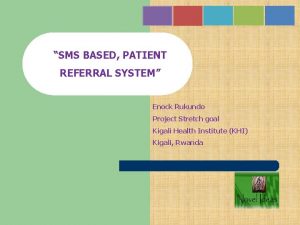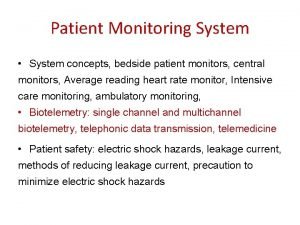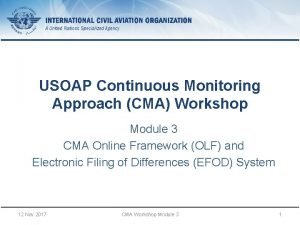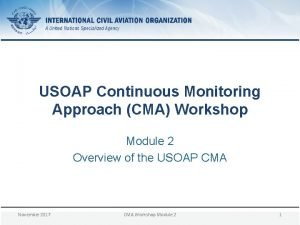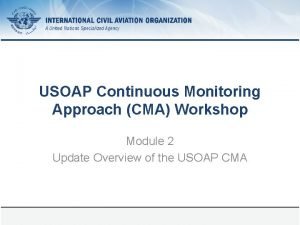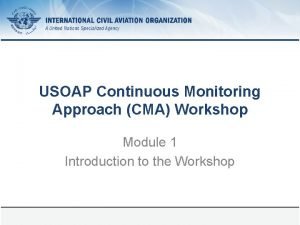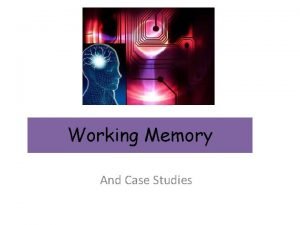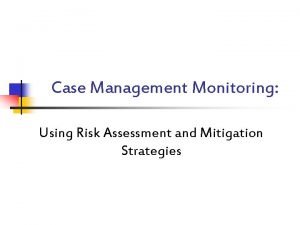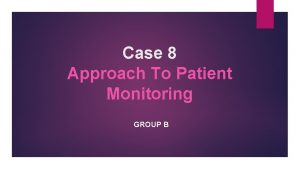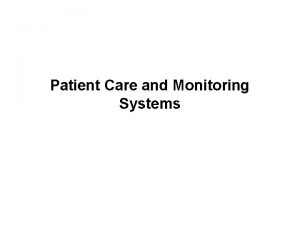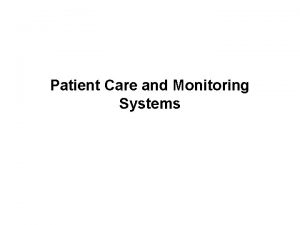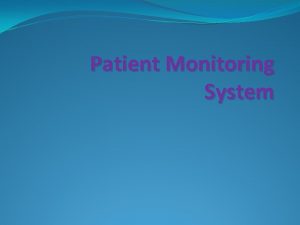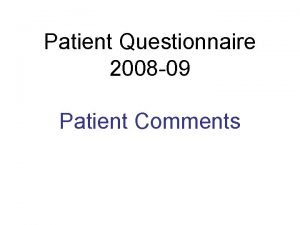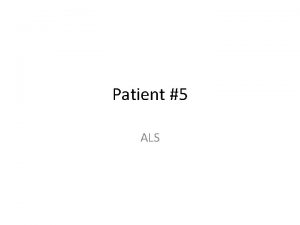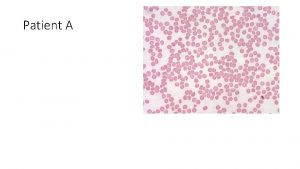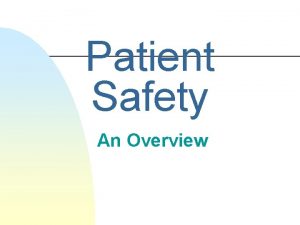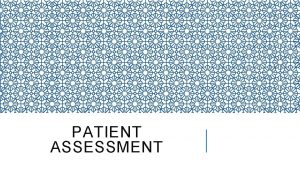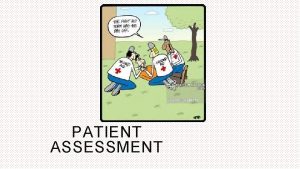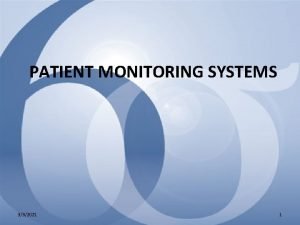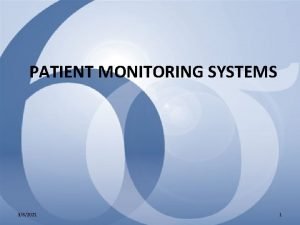CASE 10 APPROACH TO PATIENT MONITORING GROUP A




















- Slides: 20

CASE 10: APPROACH TO PATIENT MONITORING GROUP A

• A-65 years old patient attended the operating theatre for vaginal hysterectomy. • She is a known diabetic, controlled with oral medication. • After induction of general anesthesia the patient developed hypotension so inhalational agent reduced to 1% • Anesthesia was maintained by sevoflurane 1 % and frequent dose of muscle relaxant then patient extubated and shifted to the PACU • 2 days after, the surgeon call the anesthesia because patient complain of recall conversation in OR and she was paralyzed feeling pain can’t alert anybody because tube of in her throat (awareness under anesthesia )

Q 1: DISCUSS THE ASA STANDARD MONITORING FOR THIS PATIENT?

• The patient Is classified as ASA class 2 because she has a controlled systemic disease. (DM on oral hypoglycemics) • The patient’s oxygenation, ventilation, circulation and temperature shall be continually evaluated.

Q 2: WHAT ARE THE METHODS FOR MONITORING AWARENESS UNDER ANESTHESIA?

Cardiovascula r Temperature Respiratory Mentoring During Anesthesia Peripheral nerve stimulation Neurological Urine output

• No single technique or equipment is perfect for monitoring and detecting awareness. • Currently, bispectral index monitoring is popular. The autonomic changes that are monitored include: • Pupil size and reactivity: Unreliable indicators. Mydriasis may be caused by anticholinergics (e. g. atropine, hyoscine ), whilst opiates cause miosis. • Changes in blood pressure: May be related to other factors, such as circulating catecholamines and drugs (e. g. beta blockers). • Heart rate variability: There is a reduction in respiratory sinus arrhythmia with anaesthesia. • Sweating and lacrimation are also warnings of awareness.

METHODS AVAILABLE TO MONITOR AWARENESS INCLUDE THE FOLLOWING: Electroencephalograph (EEG): • Tracks and records brain wave patterns Bi-spectral index (BSI): • a simplified EEG which uses an algorithm that converts EEG signals into an index of hypnotic level. Isolated forearm technique (IFT): • Blood pressure cuff before giving neuromuscular block agents then patients asked to squeeze their hands. Evoked potentials : 1)Auditory evoked potentials (AEPs) Auditory clicks via headphones 2)Visual evoked potentials 3)Somatosensory evoked potentials Peripheral Stimuli (median nerve)

Q 3: DISCUSS NON ROUTINE MONITORS TO DETECT AWARENESS UNDER ANESTHESIA?

Isolated forearm technique (Mainly used as a research tool) : • A blood pressure cuff is inflated and maintained above systolic BP. • Done before any neuromuscular blocking drug is given, leaving the limb distal to the cuff unaffected and able to mount a motor response. • Movement, either spontaneous or in response to command, can then be observed. • Limb ischemia caused by the tourniquet occurs and the adequacy of motor response is insufficient after 20 minutes.

Electroencephalogram (EEG): • Not practical to be used routinely (both in terms of equipment and interpretation) • With increasing depth of anesthesia, there is an increase in average wave amplitude and a decrease in average frequency. • There is also a progressive change from beta to delta waveform. Patient state analyzer index (PSA): Works by processing changes in anterior-posterior distribution of EEG, using more extensive electrode sensor than BSI.

Bispectral index (BIS) • a simplified EEG which uses an algorithm that converts EEG signals into an index of hypnotic level. 100 Awake • Readings range from 0 to 100. 60 -80 measure of sedation 40 -60 General anesthesia 0 No EEG activity https: //www. youtube. com/watch? v=EAtd. Fwb

EVOKED POTENTIALS : Auditory-evoked potentials Visual-evoked potentials Somatosensoryevoked potentials Electrical activity passing from the cochlea to auditory cortex. The patient wears goggles with light-emit-ting diodes lying within them. stimuli are placed peripherally (e. g. median nerve) and the response is recorded over the cervical vertebrae and the contralateral somatosensory cortex. EEG analysis shows characteristic waveforms whose amplitude decreases and latency increases with depth of anaesthesia Visual-evoked potentials, which are detected and recorded over the visual cortex. Each calculation takes over 1 minute and results are inconsistent.

EVOKED POTENTIALS : Auditory-evoked potentials Visual-evoked potentials Somatosensoryevoked potentials Electrical activity passing from the cochlea to auditory cortex. The patient wears goggles with light-emit-ting diodes lying within them. stimuli are placed peripherally (e. g. median nerve) and the response is recorded over the cervical vertebrae and the contralateral somatosensory cortex. EEG analysis shows characteristic waveforms whose amplitude decreases and latency increases with depth of anaesthesia Visual-evoked potentials, which are detected and recorded over the visual cortex. Each calculation takes over 1 minute and results are inconsistent.

Q 4: WHICH PATIENT HAS RISK OF AWARENESS?

Table I shows the major and minor criteria of awareness frequency during general anaesthesia. The patient with the higher risk for awareness is the one with at least one major risk criterion or two minor risk criteria.

RISK FACTORS • Anesthetic underdosing — The most important contributing factor for awareness with recall (AWR) is underdosing of anesthesia relative to a given patient's specific requirements. This can occur for the following reasons: • The anesthetic technique results in inadequate anesthesia. • A specific patient's needs are underappreciated. • It is judged unsafe to administer sufficient anesthesia. • There is a mistake or failure in the delivery of anesthesia.

• Total intravenous anesthesia — Total intravenous anesthesia (TIVA) is probably associated with a higher risk for AWR compared with techniques based on a volatile inhalation agent. • Neuromuscular blockade — Use of an NMBA is associated with increased risk and severity of AWR. • Resistance or tolerance to anesthetics — Patients who have a history of AWR may be at higher risk for future events. • Type of surgery — Surgical procedures with higher risk for AWR include trauma or cardiac surgery and cesarean delivery. • Technical issues — Equipment malfunction and human error are infrequent causes of AWR. During a TIVA technique, infiltration of the intravenous (IV) catheter or a dosage miscalculation may result in inadequate anesthesia.

REFERENCES : • Anesthesia at glance by Julian & William • https: //www. ncbi. nlm. nih. gov/pmc/articles/PMC 2900098/ • http: //www. europeanreview. org/wp/wp-content/uploads/1038. pdf

1) Kholoud Fadel Aldosari 2) Shahad Abdullah Almuhaideb 3) Zhour Abdullah Alhedyan 4) Norah Fahad Alnaeim 5) Waad Fahad Aldahlawi 6) Shaikha Mohammed Almoqati 7) Deema Ibrahim Alturki 8) Fadah Abdlkarim Alanazi 9) Najoud Marzooq Alotaibi 10) Fay Saad Alruwais 11) Hadeel Khaled Alsaif 12) Ethar Ali Alqarni
 Best case worst case average case
Best case worst case average case Patient 2 patient
Patient 2 patient Sms based patient monitoring system
Sms based patient monitoring system Monitors
Monitors Patient remote
Patient remote Continuous monitoring approach
Continuous monitoring approach Cma usoap
Cma usoap Usoap cma
Usoap cma Continuous monitoring approach
Continuous monitoring approach Continuous monitoring approach
Continuous monitoring approach Patient kf case study
Patient kf case study Hm life insurance
Hm life insurance Case management monitoring
Case management monitoring Difference between virtual circuit and datagram networks
Difference between virtual circuit and datagram networks Theoretical models of counseling
Theoretical models of counseling Waterfall and shower approach
Waterfall and shower approach Multi approach avoidance conflict
Multi approach avoidance conflict Bandura's reciprocal determinism
Bandura's reciprocal determinism What is research approach definition
What is research approach definition Diagram for traditional approach
Diagram for traditional approach Tony wagner's seven survival skills
Tony wagner's seven survival skills


